The Friends of the Wildflower Garden, Inc.
Plants of the Eloise Butler Wildflower Garden
The oldest public wildflower garden in the United States
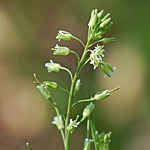
Common Name
Smooth Rockcress (Smooth Bankcress)
Scientific Name
Boechera laevigata (Muhl. ex Willd.) Al-Shehbaz
Plant Family
Mustard (Brassicaceae)
Garden Location
Woodland
Prime Season
Spring Flowering
Smooth Rockcress is a native biennial. Stems are erect, growing to 3 to 3-1/2 feet high, smooth, green with minor branching into secondary stalks.
Leaves: The first year of growth produces a basal rosette of leaves that are obovate in shape, are up to 3-1/2 inches long and have margins that are shallowly lobed - the lobes resembling large shallow teeth. The leaves can also have some fine hair and may be tinged with purple. In the second year when the stem rises; the stem leaves are alternate and are longer than the basal leaves, as much as 8 inches long, but are narrow, lanceolate in shape and hairless with mostly smooth margins. Lower stem leaves clasp the stem with 2 basal lobes known as auricles.
The inflorescence is a tall raceme of 16 to 45 individually stalked flower buds. The raceme expands from a tight cluster of buds and grows taller as individual flowers open and their stalks lengthen with the open flower facing outward 90 degrees or more from the raceme stem. Branching sometimes occurs in the inflorescence.
Flowers: They are small (1/6 inch wide) 4-part, white petals on the corolla and 4 light green sepals on the calyx. These sepals are ovate shaped, slightly shorter than the petals and are erect along the outside of the flower. The sepals are alternate with the petals so that the slightly longer white petals poke out between the overlapping sepals. The petals have their apex edges slightly flared outward and the edges may be blunt or slightly wavy. There are six stamens with yellow anthers arranged in pairs with the outer pair shorter than the other pairs (said to be "tetradynamous") and one short style. Like many mustard family plants the flowers that open at the apex of the raceme already have fruit pods formed below from maturing flowers.
Fruit: Flowers mature to a long thin pod, more rounded than flat in cross section, which spreads outward and then curves downward. There is a small beak at the end of the pod. The pod contains a single row of seeds, each about 1 mm wide and slightly longer, that have winged margins which helps them spread by wind when the pod breaks open.
Habitat: Smooth Rockcress grows from taproot and since it is biennial, it propagates from reseeding. It will prefer shade or partial sun with average loamy soil and moderate moisture. It will generally be found on hillsides of open woods. In the Garden it can usually be found along Geranium path on the west side of the Woodland Garden. The tall thin plant can be easily overlooked.
Names: Based on DNA analysis, botanists have reclassified this plant and a number of others from the Arabis genus to the genus Boechera. Flora of North America provides a full description of this process. (Ref. W7) The University of Minnesota Herbarium has adopted this change on its Checklist of the Vascular Flora of Minnesota. (Ref. 28c). The genus name Boechera, is an honorary for Danish cytogeneticist Tyge Wittrock Böcher, 1909-1983. The species name, laevigata, means 'smooth' or 'free from hair'.
The author names for the plant classification, 'Muhl. ex Willd.' are as follows: ‘Muhl’ is for for Gotthilf Heinrich Ernst Muhlenberg (1753-1815) American Botanist who produced several catalogues of plants after retiring as a Lutheran pastor. His work was incomplete and amended by ‘Willd.’ who is Carl Ludwig Willdenow (1765-1812), German botanist, a founder of the study of the geographic distribution of plants. He was director and curator of the Botanic Garden of Berlin. The plant was originally named Turritis laevigata in 1801, then became Arabis laevigata. Their work was amended in 2003 by ‘Al-Shehbaz’ who is Ihsan Ali Al-Shehbaz (b. 1939) Iraqi-American botanist, senior curator at the Missouri Botanical Garden and world authority on the phylogeny and systematics of the Brassicaceae family.
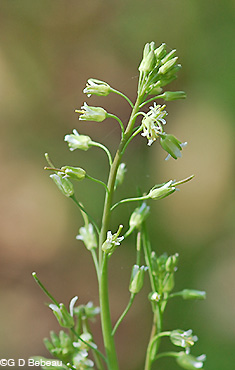
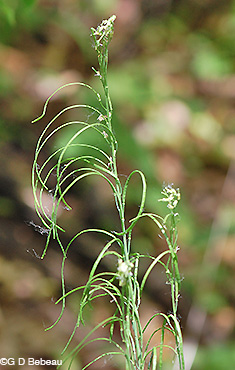
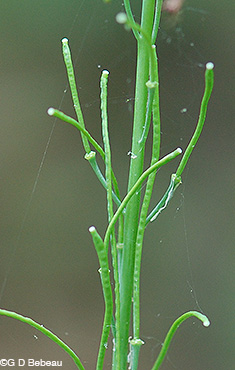
Above: Progression of development: 1st photo - The flower raceme expanding with unopened buds at top, open flowers and then flowers maturing to seed pods at bottom. 2nd photo - Fully developed seed pods in their characteristic outward spread and droop. 3rd photo - Individual seed pods are thin, roundish, with a single layer of seeds and a beak at the end of the pod.
Below: An open seed pod showing the placement of seeds. Note the thin membrane around the seed forming a wing.
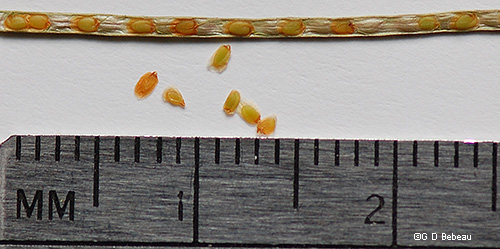
Below 1st photo - The flower raceme begins as a tight cluster and then elongates as shown in a previous photo. 2nd photo - Individual flowers have 4 light green sepals erect around the outside and almost as long as the 4 white petals which are alternate with the petals.
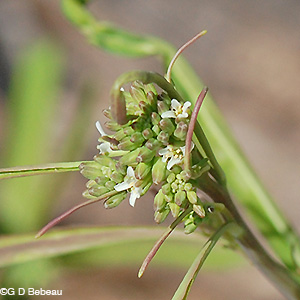
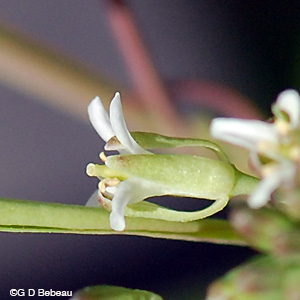
Below: 1st photo - A basal leaf with the characteristic shallow lobes. 2nd photo - The stem leaves have mostly smooth edges and are longer than the basal leaves.
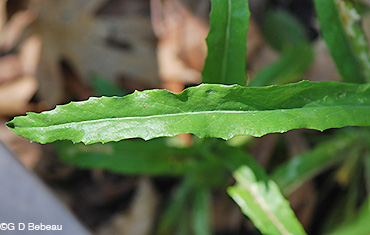
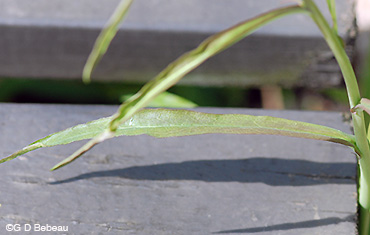
Below: 1st photo - The first year basal rosette remains as the second year flowering stem rises. Basal leaves may have a purplish tinge as shown here. 2nd photo - Their bases have two auricles which clasp part way around the smooth stem.
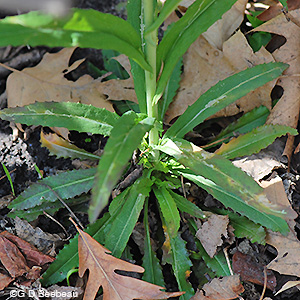
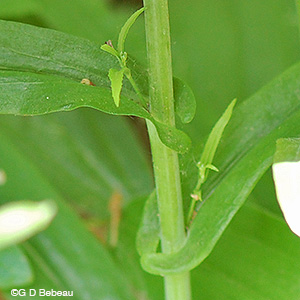
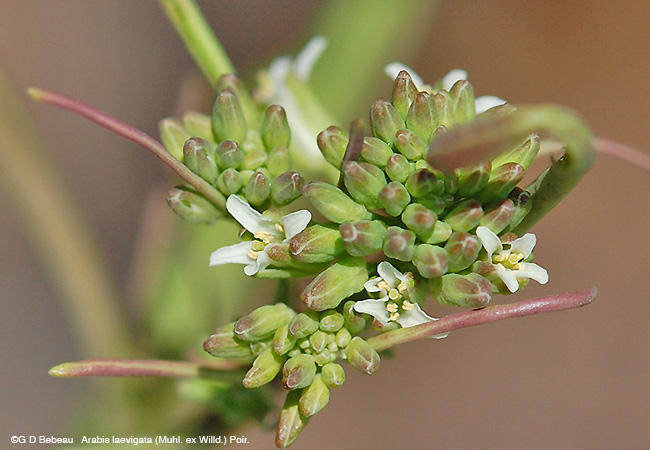
Notes: Smooth Rockcress is not indigenous to the Garden. It was not listed on any Garden census until 1986. Smooth Rockcress is found in North America from the mid-continent eastward with the exception of Louisiana and Florida in the U.S. and the maritime provinces in Canada. In Minnesota it is quite restricted in the wild, known only from 7 counties, Dodge, Hennepin, and in the SE - Olmsted, Mower, Fillmore, Winona and Houston. More prevalent in Wisconsin, Minnesota is on the western edge of its range. It is listed on the Minnesota DNR "Special Concern" species list. Much more frequently found in the state is Boechera grahamii, the Spreading Rockcress which has widely spreading branched inflorescence.
Six species of Boechera are found in Minnesota: B. canadensis, Sicklepod; B. dentata, Short's Rockcress; B. grahamii, Spreading-pod Rockcress; B. laevigata, Smooth Rockcress; B. retrofracta, Second Rockcress; and B. stricta, Drummond's Rockcress. One other is reported but has not been collected recently - B. collinsii, Collins' Rockcress; and one other is known from only one population - B. missouriensis, Green Rockcress.
Return to -- Site Plan/Archive Index --or-- List of Common Plant Names -- or -- List of Scientific Names -- or --Home Page - - - Back to top.
References: Plant characteristics are generally from sources 1A, 32, W2, W3, W7 & W8 plus others as specifically applied. Distribution principally from W1, W2 and 28C. Planting history generally from 1, 4 & 4a. Other sources by specific reference. See Reference List for details.
 Identification booklet for most of the flowering forbs and small flowering shrubs of the Eloise Butler Wildflower Garden. Details Here.
Identification booklet for most of the flowering forbs and small flowering shrubs of the Eloise Butler Wildflower Garden. Details Here.
©2014
Friends of the Wildflower Garden, Inc. Text and photos are by G. D. Bebeau unless otherwise credited. "www.friendsofeloisebutler.org"
043020